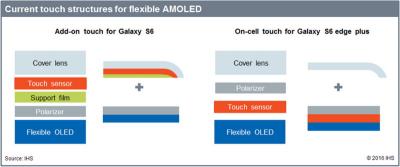LG Chem sells its LCD polarizer business, to focus on its OLED polarizers
LG Chem announced that it has sold most of its LCD polarizer business to China’s Ningbo Shanshan, in a $1.1 billion deal. LG Chem will retain its automotive LCD polarizer business, and aims to focus on "strengthening its competitiveness in tech materials, especially OLED and nurture its OLED polarizer business". In 2018 DSCC estimated that the OLED circular polarizer market will grow from $428 million in 2017 to $1.27 billion in 2022. The market is still dominated by mobile displays. In 2018 the OLED circular polarizer market was led by Sumitomo Chemical and Nitto Denko, with LG Chem increasing its market share in OLED TVs polarizers.
In 2018 DSCC estimated that the OLED circular polarizer market will grow from $428 million in 2017 to $1.27 billion in 2022. The market is still dominated by mobile displays. In 2018 the OLED circular polarizer market was led by Sumitomo Chemical and Nitto Denko, with LG Chem increasing its market share in OLED TVs polarizers.








